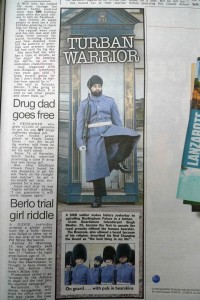A clip from The Sun on 12.12.12
The image of a Sikh soldier used to illustrate the increasing diversity of British society this week ought not to pass without comment. The turbaned Scots Guardsman Jatenderpal Singh Bhullar was photographed both on his own and with his colleagues in their trademark bearskins in a carefully placed intervention intended to demonstrate two crucial points: first, that the UK has successfully weathered the integration of postcolonial minorities into its most symbolic institutions; secondly, that faith and culture are no barrier to inclusion within the armed forces themselves.
The bearskin headgear worn by troops in ceremonial dress attending to the Queen is, along with black taxis, double decker buses and punks, one of the chief emblems of brand UK. The scarlet coat, gold braids and tall black fluffy hat are instantly recognizable as British ‘tradition’, nectar to the tourists who flock to the capital the whole year round. The striking visual image of a dark-skinned face under the iconic black fur makes it an obvious opportunity for showcasing London’s happy multicultural face.
But Gdsmn Bhullar is not a member of the elite Household Cavalry normally associated with this role, which explains why he is wearing a long grey overcoat and not the red jacket. As a member of the Scots Guards he belongs to a regular infantry regiment, the only difference being that as part of his training he would be required to carry out public duties as a guard at Buckingham Palace, St James’s Palace, the Tower of London and Windsor Castle.
While there are several black soldiers in the Household Cavalry who could have been photographed to illustrate Britain’s modern military, the key details in this latest version of militarized multiculture are not skin colour, but the turban and the beard.
The fact that these items are on show in army uniform, in whatever role or regiment, speak less of a natural process of enlightenment than the effect of progressive laws on discrimination. There is a chapter in Military Migrants that documents this process. The Employment Equality Regulations, which came into force in December 2003, incorporated the religion and belief elements of the European Employment Framework Directive into UK legislation. The ‘Guide on Religion and Belief’ published by the Ministry of Defence explained that this new legal obligation made it unlawful to discriminate against personnel on the grounds of religion or belief:
“The Armed Forces and MOD Civil Service have been practising policies that respect individuals’ religion or belief for some time. However, it is important to understand that, where in the past MOD as a matter of policy aimed not to discriminate, the new Regulations make discrimination on the grounds of religion or belief unlawful and give individuals a right to bring Employment Tribunal claims for breaches of the Regulations.”
This step towards becoming an official multi-faith employer was thus mandated by law, reflecting the extent to which, as a national institution, the armed forces were simply conforming to an expanded HR agenda and the demands of a corporate multiculturalist script. The fact that a soldier can wear a turban is a sign of the successful campaigns by Indian bus conductors and drivers in the 1960s, at least two generations ago. It ought not to be front page news in 2012.
But there is another aspect of this recent history that cannot be explained in such simple terms. Young men and women of South Asian descent in the UK form an important pool for army recruiters for demographic reasons alone. There has been a great deal of time and resources spent on targeting gurdwaras and mosques in an attempt to encourage communities to see the armed forces as a respectable and attractive profession. This is where it gets contentious.
A recent video made specially for the recruitment of young Sikhs places great emphasis on the martial tradition of Sikhs in the British Empire up to the end of WW2. Young would-be recruits are shown round Sandhurst by a Sikh officer who proudly points out the artifacts and memorials to the British Indian Army, indicating that membership of the UK armed forces is part of their ethno-cultural heritage.
Historically Punjabi Muslims played a parallel role in the British Indian Army, which was famously run on ethnically divided lines after the Uprising in 1857. But it is hard to imagine a recruiting pitch aimed at young Muslims stressing their military heritage in the same way. For British Muslims there is unease at the way Sikhs are singled out for their military prowess with the implication that other ethno-cultural groups from South Asia who took part in Europe’s global conflicts were not appreciated or valued to the same extent.
The young Sikh guardsman in his ill-fitting overcoat does not provide proof of the successful integration of Britain’s postcolonial settlers. Instead he offers a reminder of the country’s imperial heritage which continues to transmit divisive and deep-running conflicts into the heart of contemporary political and cultural life.

